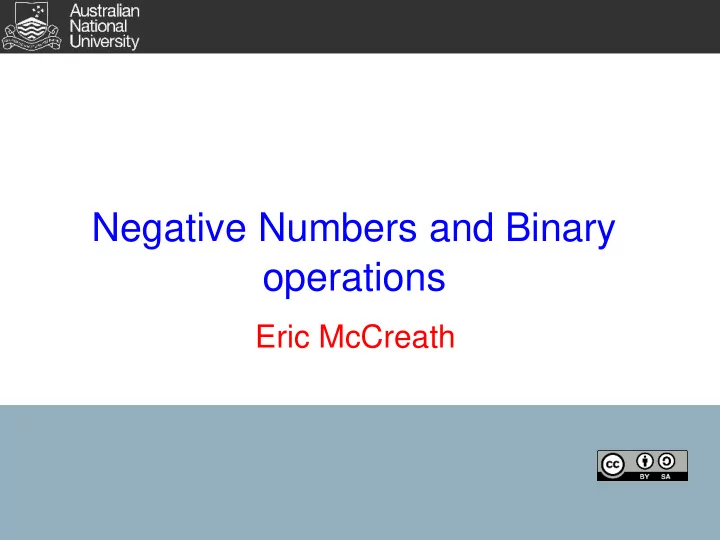

Negative Numbers and Binary operations Eric McCreath
Binary Addition Adding binary numbers is very similar to how you would add large decimal numbers in primary school It involves positioning the numbers such that the columns line up in their powers, Then adding the single digits of the corresponding powers, If the result is larger than what can be contained in that power then carry one to the next column Try the following and check by converting the numbers to decimal (repeating the addition in decimal) 2
Binary Subtraction Subtracting binary numbers is also very similar to how you would subtract large decimal numbers in primary school The process is similar to addition The main difference is subtracting the corresponding digits and also the carry Try the following and check by converting the numbers to decimal. 3
Negative Integers A very simple way of representing negative integers is to reserve one bit as the sign bit The reserved bit is normally the most significant bit where 0 means a positive number and 1 means negative If 1 byte words are being used, then: Using this method, 8-bit numbers range from -127 - 127 This approach has two main problems: First, results in 2 zeros - this wastes a bit pattern and also makes equality more complex Second, addition or subtraction is not as simple 4
Negative Integers Another approach for representing negative integers is to offset the unsigned integer value In the example below, a 3 bit unsigned integer is being used with an offset of -4 With this approach we only have one zero, although, normal addition will not work 5
Two's Complement The two's complement representation of signed integers is the most common approach. Only one zero is represented and normal binary addition can be used. The left-most (or most signficant bit) still indicates sign (0 - positive; 1 - negative) 6
Two's Complement A 3 bit two's complement representation would have the following mappings: 7
Two's Complement To negate a 2's complement number: flip all bits and add one or flip the bits to the left of the right-most 1 8
Two's Complement When adding 2's complement numbers, use normal unsigned addition and discard any overflow With 4-bit 2's complement numbers try the following: 9
Overflow An arithmetic overflow occurs when the result of an operation is too large (or small) to be represented This can normally be detected by looking at an overflow flag in the status register (or checking the sign of the resulting number is as expected) There are different approaches for dealing with the overflow problem. These include: designing the program such that numbers will not be out of range avoiding the situation by checking the numbers before and after an operation setting up an exception propagating the overflow or ignoring the problem. 10
Recommend
More recommend